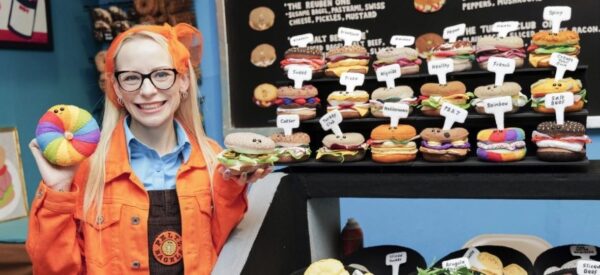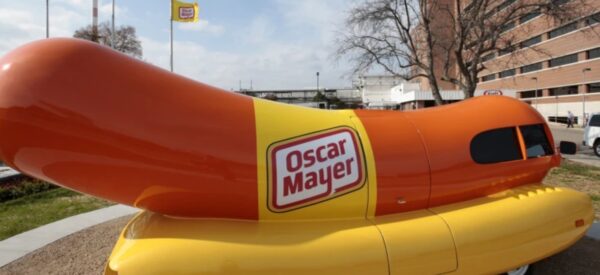Never a dull moment this week as the Loch Ness monster did not rear it’s ugly head, but a brown bear in Alaska did become a local celebrity; meanwhile, food and art intersected in truly bizarre ways, and wait for it, an update on the Wienermobile – all in our wonderful, wacky world.
MONSTER MASH
Mystery hunters converged on a Scottish lake recently to look for signs of the mythical Loch Ness Monster. Participants sought of Nessie using thermal-imaging drones, infrared cameras and a hydrophone to detect underwater sounds in the lake’s murky waters. The two-day event was billed as the biggest survey of the lake in 50 years and included volunteers scanning the water from boats and the lakeshore, with others around the world joining in with webcams.
Alan McKenna of the Loch Ness Centre said the aim was “to inspire a new generation of Loch Ness enthusiasts.” He added, “Not every ripple or wave is a beastie. Some of those can be explained, but there are a handful that cannot.”
Many believe the sightings are pranks or can be explained by floating logs or strong winds, but the legend is a boon for tourism in the picturesque Scottish Highlands region.
IN THE EYE OF THE BEHOLDER
A Danish artist who was given a pile of cash by a museum in northern Denmark to create a piece for its exhibition on labour conditions two years ago submitted two empty canvases — titled “Take the Money and Run.” The exhibit caused a stir – in a lawsuit.
A Danish court ruled that Jens Haaning has to repay 492,549 kroner ($69,894) to Kunsten Museum in Aalborg for having violated his contract. The museum had commissioned Haaning in 2021 to recreate two of his earlier pieces featuring bank notes attached to canvases representing the average annual wage in Denmark and Austria. Instead, he submitted two empty canvases for the exhibition, entitled “Work It Out,” said the artwork represented his current work situation, and kept the money.
IN THE STOMACH OF THE BEHOLDER While not one of the major food groups, a bagel and a schmear made of felt might satisfy your appetite for art. “Feltz Bagels,” the latest installation from British artist Lucy Sparrow uses approximately 30,000 pieces of felt to recreate the look and feel of the authentic Jewish bagel shops prominent in New York’s Lower East Side neighbourhood (photo).
While not one of the major food groups, a bagel and a schmear made of felt might satisfy your appetite for art. “Feltz Bagels,” the latest installation from British artist Lucy Sparrow uses approximately 30,000 pieces of felt to recreate the look and feel of the authentic Jewish bagel shops prominent in New York’s Lower East Side neighbourhood (photo).
Sparrow says she wanted to depict how this breakfast food brought by Eastern European immigrants in the late 19th century “morphed into New York society” and beyond, making the bagel the Swiss Army knife of breads. Cream cheese, butter, cold cuts, lox – anything that fits on the circular bread is fair game, Sparrow felt.
Adding a dose of reality, Sparrow works the counter, taking orders for the bagel of your dreams – or your regular order, if you’re so inclined. The custom bagel sells for $250, and pricing for other items starts at $10.
SADLY, WE CAN RELATE
When it comes to packing on the pounds to survive winter, this year’s undisputed champ is Grazer – also known as Bear 128 to the fans of Fat Bear Week at Alaska’s Katmai National Park and Preserve. The popular brown bear won this year’s contest, handily defeating Chunk 108,321 to 23,134 in the finals.
The annual contest, which this year drew more than 1.3 million votes from dedicated fans watching the bears live at explore.org is a way to celebrate the resiliency of the estimated 2,200 brown bears that live on the preserve on the Alaska Peninsula, which extends from the state’s southwest corner toward the Aleutian Islands.
Viewers of Alaska’s most-watched popularity contest are glued to computer screens all summer long to see which bears are stocking up the most on salmon. They then vote in tournament style brackets over the course of a week, advancing bears to the next round until a champion is crowned.
SOME NAMES ARE JUST THE WURST Just four months after announcing that the hot dog-shaped Wienermobile (photo) was changing its name to the Frankmobile, the distinctive wiener on wheels is reverting to the original. Oscar Mayer, which has several of the vehicles announced on Instagram that the Frankmobile is toast and the Wienermobile rides again.
Just four months after announcing that the hot dog-shaped Wienermobile (photo) was changing its name to the Frankmobile, the distinctive wiener on wheels is reverting to the original. Oscar Mayer, which has several of the vehicles announced on Instagram that the Frankmobile is toast and the Wienermobile rides again.
The name change announced by The Kraft Heinz Company in May was meant to pay homage to the brand’s 100% beef franks and their new recipe. For fans of the original name, the change was, frankly, ridiculous.
“It’s been a franktastic summer!” the Instagram post said. “But like you, we missed this BUNderful icon. Help us welcome back the Wienermobile!”
Oscar Mayer was headquartered in the Wisconsin capital, Madison, for nearly 100 years before it moved to Chicago in 2015. The first Weinermobile was created in 1936, and it has gone through several iterations since then. Those who drive Wienermobiles around to promotional events are known as Hotdoggers.

